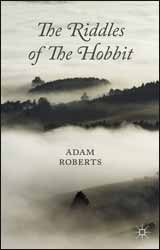|
Click here to return to the main site. Book Review
In the run up to The Desolation of Smaug it was inevitable that a number of books would appear in the run up to December. We await a plethora of glossy books full of colour and little insight. What wasn’t expect was the publication of Adam Roberts, The Riddles of The Hobbit (186 pages), a scholarly book, but one which is not impenetrable to the casual reader. Roberts postulates that The Hobbit’s riddles are not confined to the chapter 'Riddles in the Dark' but that the whole book can be read as one large meta-riddle. He builds his argument carefully, setting out his contentions in the extensive introduction, before building his case on the importance of riddles in the Anglo-Saxon world and Cynewulf and the Exeter book, all the time referencing back to The Hobbit and Tolkien’s other works. He builds his argument carefully and as a whole it does hold together. To some extent Tolkien must take some blame, his own answers to pretty direct questions about both The Hobbit and The Lord of the Rings could be frustratingly contradictory, which opens both texts up to external interpretation. However, one of the problems with constructing a thesis based on The Hobbit being a meta-riddle, containing lessor riddles is that even Roberts own interpretations are open to competing answers. When discussing the meaning of one of the riddles Roberts comes up with his own interpretation of the answer. This thing all things devours; Now, the original answer to the riddle is ‘time’, but Roberts postulates that this can actually be read as Smaug, a character known to both Tolkien and Bilbo, at that point in the story. However, it can also be read as a prescient description of the ring itself. The existence of the ring guarantees the continual destruction which the wars create, the contest for the ring threatens the destruction of Middle-Earth itself. This counter- interpretation is no more farfetched as Roberts's contention that when Bilbo introduces himself to the Trolls as a ‘burrahobbit’ the internalised riddle is that in fact ‘burra’ references a middle English work for ‘ring’ so, rather than an amalgamation of burglar and Hobbit, Bilbo is conceptualising himself as a ring-hobbit, or at least Tolkien is as Bilbo has yet to find the ring when he meets the trolls. Roberts has a very clean style of writing, which succeeds in not talking down to the audience, whilst at the same time not disappearing up its own scholarly arse. The language used invites readers to follow Roberts’s line of argument without descending into specialist language in an attempt to make the book exclusive. Did I agree with his reading of the text? Well, he makes a compelling argument, but what I most enjoyed about the book is that it made me think about the text in another way adding another layer to what many consider just a book for kids. 9 Charles Packer Buy this item online
|
|---|



